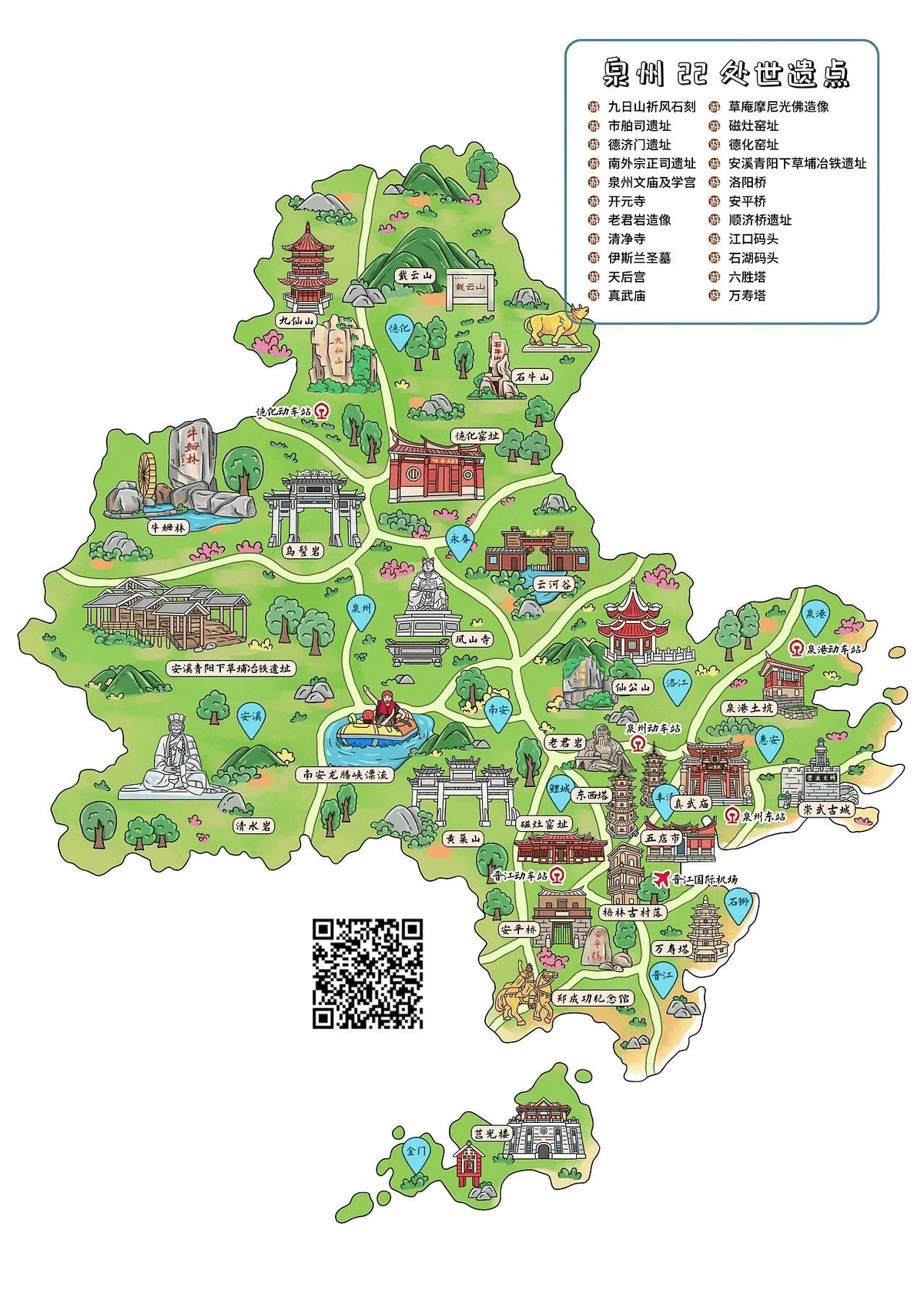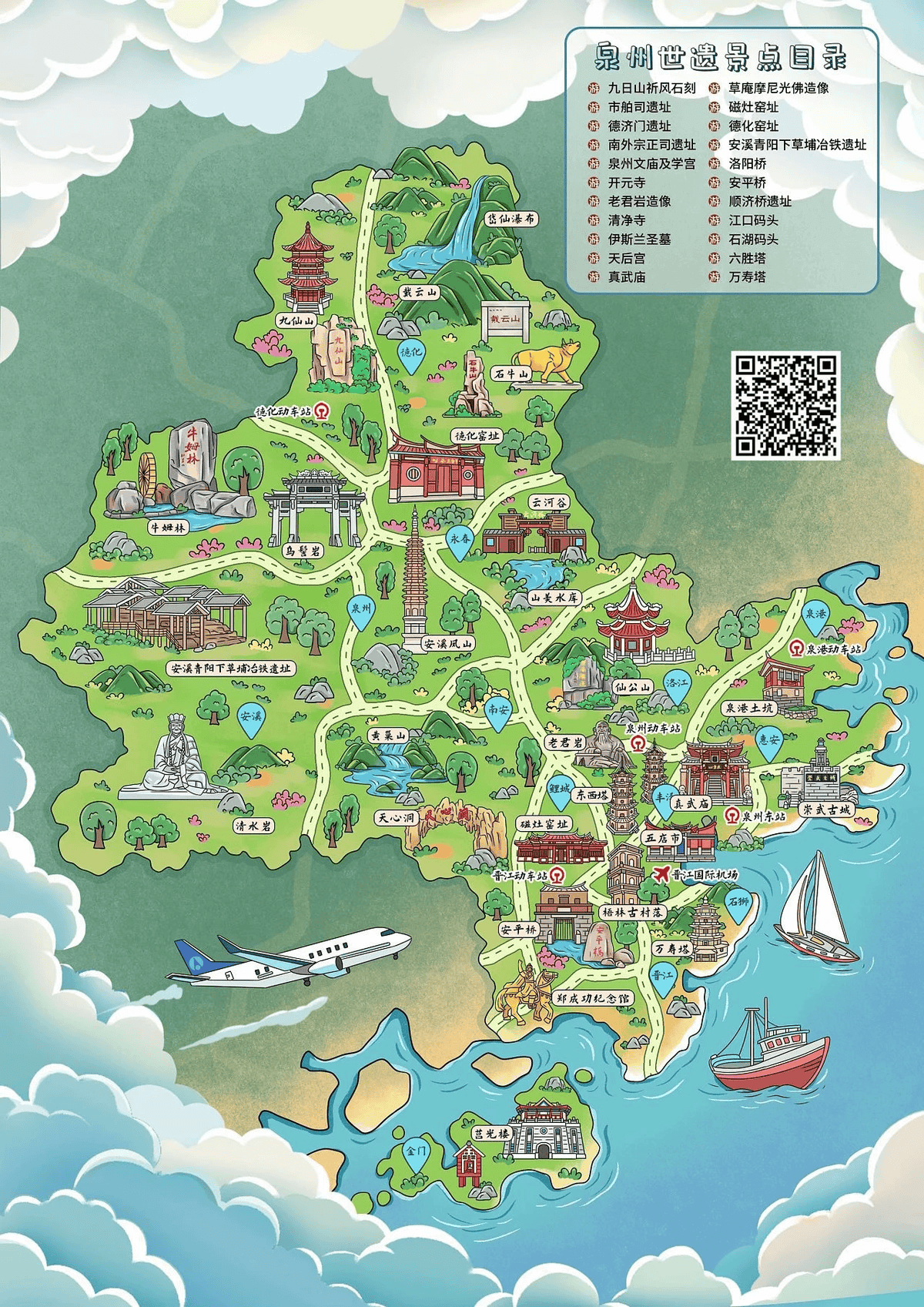Introduction
In the world of cartography, where precision often dominates aesthetics, illustrated maps stand as beautiful bridges between information and art. The recently created illustrated map of Quanzhou World Heritage sites (泉州世遗景点图录) represents a masterclass in cultural storytelling through visual design. This vibrant creation transforms UNESCO-designated landmarks into an engaging visual journey that invites exploration while preserving the rich heritage of this historic maritime emporium. Let's dive into the fascinating process behind how the talented team at Mapful.Art brought Quanzhou's cultural treasures to life on paper.
The Foundation: Research and Content Planning
Before the first sketch could begin, the Mapful.Art team embarked on a comprehensive research journey. Quanzhou's UNESCO designation as "Quanzhou: Emporium of the World in Song-Yuan China" encompasses numerous historical sites representing the city's golden age as a maritime trading hub during the 10th-14th centuries.
The research phase involved:
- Compiling all 22 heritage components visible in the map's legend
- Determining geographical relationships between scattered sites
- Identifying each location's distinctive architectural and natural features
- Gathering cultural and historical context for authentic representation
This meticulous groundwork ensured that the final map would not merely be beautiful but historically accurate and culturally meaningful.
Artistic Vision: Map Stylization and Design Approach
The team's creative decisions transformed what could have been a simple directional tool into a work of art through several key strategies:
Artistic Abstraction
Rather than adhering to strict geographical precision, the team created a stylized island-like representation of Quanzhou. This artistic license enhanced visual appeal while maintaining the essential spatial relationships between sites.
Strategic Color Psychology
The color palette wasn't chosen merely for beauty but for intuitive understanding:
- Vibrant greens represent natural landscapes and parks
- Blues indicate water bodies, emphasizing Quanzhou's maritime significance
- Warm reds and oranges highlight cultural structures, drawing the eye to key heritage sites
Visual Hierarchy
Major attractions like temples and bridges receive larger, more detailed illustrations, immediately communicating their significance to viewers.
Cohesive Iconography
The team developed a consistent visual language for architectural features that maintains Chinese identity while remaining accessible to international visitors.
Intuitive Navigation Elements
White pathways connecting sites create a natural visitor journey, subtly guiding tourists through the optimal exploration route.
Preserving the Soul: Cultural Authenticity
Perhaps the most impressive aspect of the Quanzhou heritage map is its unwavering commitment to cultural authenticity. The Mapful.Art team ensured this through:
- Meticulous depictions of traditional Chinese architectural elements like pagodas, temples, and ornate gates
- Exclusive use of traditional Chinese calligraphy for all site names
- Integration of culturally significant symbols and motifs throughout the design
- A color palette that resonates with Chinese aesthetic traditions
- Cloud border designs reflecting traditional Chinese artistic styles
These elements transform the map from a mere tourist guide into a cultural artifact that celebrates and preserves Quanzhou's heritage.
Practical Magic: Tourist-Friendly Features
Beyond its artistic merits, the map excels as a practical tool for visitors through thoughtful inclusions:
- A numbered reference system that matches the comprehensive legend, allowing quick site identification
- A prominently placed QR code providing access to additional digital information
- Clear visual differentiation between types of attractions (religious sites, bridges, natural features)
- Simplified transportation representations (ships, planes) indicating accessibility options
- A complete legend listing all heritage sites in both Chinese and English
These practical elements ensure the map functions effectively for its primary purpose—guiding visitors through Quanzhou's UNESCO treasures.
Behind the Scenes: Technical Execution
The technical process behind this artistic achievement likely followed a sophisticated creative workflow:
- Conceptualization: Initial hand sketching to explore different approaches
- Digital Framework: Development of the base map with key geographical elements
- Illustration: Detailed vector-based graphics for clean lines and scalability
- Color Application: Digital coloring with texture overlays for visual depth
- Typography Integration: Careful placement of traditional calligraphy and informational text
- Final Refinement: Adjustments to ensure both aesthetic harmony and informational clarity
Conclusion
The Quanzhou World Heritage illustrated map stands as a testament to the power of visual storytelling in cultural preservation. The Mapful.Art team has achieved that rare balance between artistic expression and practical utility, creating a guide that educates visitors while celebrating the rich cultural heritage of Quanzhou's Maritime Silk Road history.
This illustrated map isn't merely a navigational tool—it's an invitation to journey through time, exploring the sites that earned Quanzhou its UNESCO designation. Through thoughtful research, artistic skill, cultural sensitivity, and practical design, Mapful.Art has created a visual celebration of heritage that will guide and inspire visitors for years to come.
For travelers and map enthusiasts alike, this creation demonstrates how cartography, when approached with both artistic vision and cultural respect, can transform complicated heritage information into an accessible, engaging experience that honors the past while serving present-day explorers.

